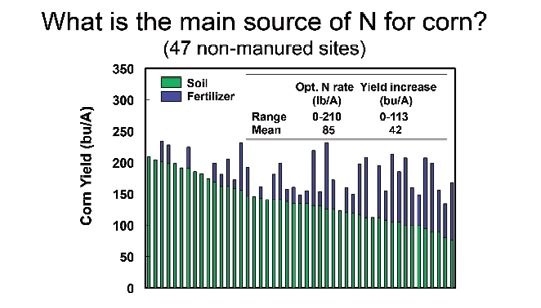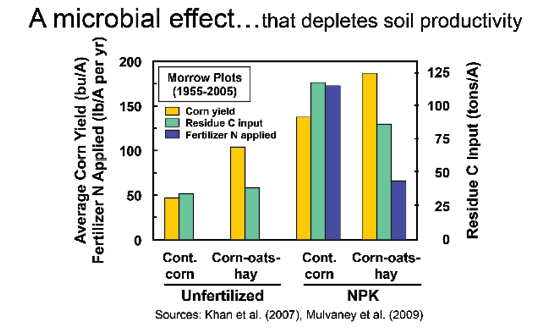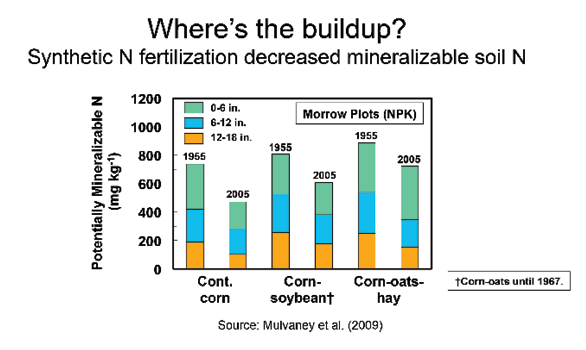If you think applying extra nitrogen (N) to fields will bank it for future crops, or build organic matter, Richard Mulvaney begs to differ.
After several years poring over data from decades-long farm plots across the U.S. and Europe, the University of Illinois fertility specialist and fellow researchers Saeed Khan and Tim Ellsworth believe excessive N applications are “browning the green revolution” by burning up soil carbon and reducing soil N levels.
In case after case, they found that for farm ground fertilized with N-P-K, or unfertilized as a check, there was a loss, over time, in the amount of soil carbon and N. This contradicts what many growers have been taught — that N fertilizer is an important building block for increasing organic matter.
Soil is the Source
A 5-year moving average of corn yields in Illinois shows yields have improved from about 60 bushels in 1960 to nearly 180 bushels as of 2010. While many feel this is a great example of how American agriculture has succeeded, Mulvaney says there’s more to it than that.
Mulvaney has data that show N application rates began to level off around 1980, but yields have continued to march northward, so it’s hard to say how N fertilizer is the driving force for higher yields. If it’s not the fertilizer helping yields, what is it? Where is the N coming from?
“There is another source, and it’s a four-letter word called ‘soil,’” Mulvaney says.
To prove his point, Mulvaney shared yield data from 47 on-farm trials involving no manure application for at least 3 years beforehand. Researchers tracked check plots where no supplemental N was applied vs. plots depicting extra yield that came from economically optimum N rates of 0-210 pounds per acre.
Out of the 47 sites, yield increases ranged from 0-113 bushels an acre, but at 11 of the sites there was no yield increase from N fertilization. “Soil is the main source of N for corn. Good soils need less N, poor soils need more,” Mulvaney says.
He calculated the mean N application was 85 pounds per acre for the 47 trials. “Now, we all know that most farmers use a lot more than 85 pounds of N to grow corn,” he says.
Carbon Going Down
Another misconception that Mulvaney set out to disprove is that applying N builds organic matter. This is what’s commonly taught in textbooks, but if that were true, he says, farm ground should be better than ever when it comes to soil aggregation and aeration, water storage, cation-exchange and buffer capacities, mineralizable N, phosphorus (P) and sulfur, and micronutrient supplies needed to grow crops.
He says there are plenty of data sets out there that come to this conclusion, such as one from Monmouth in western Illinois published in 2007 on a field that has been planted with corn every year since 1983. After soils were sampled in 2004 from plots that represented different N rates, they evaluated the soil organic carbon (SOC) sequestration rate vs. the N rate.
The data appear to show the higher the N rate, the more SOC sequestration. But Mulvaney believes this comparison was invalid because it was assumed the zero plots were a constant over time.
So in 1983 and since then, when the plots were put under continuous corn and the ‘zero’ fields were cropped with no fertilizer input, they were being mined, Mulvaney says. Researchers took N out every year with corn, along with all the other nutrients, but nothing was put back, except the residue.
“And so what happened? Well, yields declined, and over time so did the soil’s content of organic carbon,” he says.
Ten years before that study was done, in 1994, researchers had measured 14.3 tons of carbon per acre in the 0- to 4-inch soil surface, and if the numbers for the 2004 sampling were averaged out and projected ahead, it would have come out to 12 tons. “And so we find out that the carbon was actually not increasing, but decreasing,” Mulvaney says. “That synthetic N actually wasn’t building carbon.”
Playing devil’s advocate, Mulvaney theorized that perhaps it takes more time for crops to fix carbon, and for soil microbes to go to work.
He pointed to data culled from the Morrow Plots — an area representing just 0.70 of an acre on the campus of the University of Illinois that is the oldest experimental site in the U.S. Going back to 1876, there are three rotations: continuous corn; corn and oats, which became corn and soybeans in 1967; and corn, oats and hay.
Since 1955, commercial fertilizer has been applied to some of the plots under each rotation, including check plots that were subdivided so that half began getting N, P and potassium (K), while the other half was left unfertilized.
The good news of higher yields was soon trumpeted in a fertilizer trade journal article entitled, “All the way back in one year,” and readers were led to believe that the challenges of feeding the world had been ‘solved,’ Mulvaney says.
Continuing the same theme, a 1982 bulletin entitled, “The Morrow Plots: A Century of Learning,” presented data to document an upward progression in the tons of soil organic matter under continuous corn since the beginning of N-P-K fertilization in 1955.
With this trend in mind, Mulvaney and his colleagues sampled the plots again in 2005, expecting to find 12 more tons of soil organic matter (SOM), or 7 additional tons of carbon, per acre, five decades later.
But that’s not what they found. Despite a massive increase in crop residue and carbon inputs for the fertilized plots — whether it was a corn-soybean rotation or continuous corn — it didn’t translate into more carbon storage in the 0- to 18-inch depth that was sampled. Over the same five decades, they found soil N had also decreased with or without N-P-K fertilization, regardless of the rotation.
“You add all this carbon but not a bit of it stayed in the soil. In fact, the net result over the years was a loss of soil organic carbon,” Mulvaney says. “We basically doubled the input of residue carbon when we fertilized with N, P and K compared to the check. But you didn’t do anything for the soil. It lost organic matter.”
Mulvaney began to realize that the Morrow Plots — which were conventionally tilled up until 20 years ago but are now mulch-tilled — effectively function as an incinerator that loses N as well as carbon.
“The point here is that N fertilizers don’t build soil N because the soil doesn’t work like a bank. You apply the N and soil microbes use it to burn the carbon they find in residues and soil organic matter,” he says.
Next, they checked for changes in potentially mineralizable N by analyzing soil samples collected to depths of 0-6, 6-12 and 12-18 inches, before and after five decades of synthetic N fertilization that began in 1955. The data for all three rotations showed a decrease over time.
“What that means is the soil was weaker in 2005 than it used to be,” he says. “The greatest decreases showed up in the subsurface and subsoil. That’s where the real burning takes place due to greater microbial activity where it stays moist and the roots supply carbon.”
More Vanishing
Mulvaney and his colleagues decided to expand their investigation by reviewing additional long-term studies, starting off with the world’s oldest experimental field, established in 1843 at Rothamsted, England.
‘Burning Effect’ Would Be Higher with No-Tilled Soils
Most of the plots that Richard Mulvaney, Saeed Khan and Tim Ellsworth researched in this project were conventionally tilled or mulch tilled. When asked if these issues with soil microbes using up available nitrogen would be different with no-tilled soils, this was Mulvaney’s response.
“I would expect a difference from conventional or mulch tillage, in that the burning effect would be greater for the surface soil under no-till, owing to more extensive residue cover that would maintain higher soil moisture content,” says the University of Illinois soil fertility specialist. “The higher moisture would keep the microbes more active.”
Here, the most famous experiment is with continuous wheat, and 106 years of data show a gradual decline in total soil N for the unfertilized plots and those fertilized with N, P and K — whereas the plots receiving farmyard manure gained carbon.
In another long-term study at Askov, Denmark, the same trend showed up in data covering 50 years of a wheat-root crop-barley-grass/clover rotation — soils treated with manure had more organic carbon and total soil N than was found for the N-P-K or unfertilized plots.
In contrast to Rothamsted, even the manured plot showed a loss of soil N, which Mulvaney attributed to the fact that the manure had been applied at a lower rate.
At Grignon, France, a 20-year wheat-sugarbeet study showed decreases over time in soil organic carbon and total N, with or without N-P-K fertilization.
Finally, a long-term study was cited from work by William Albrecht at Sanborn Field in Missouri, where wheat had been grown continuously with and without the use of synthetic N that was introduced when the site was established in 1888.
In both cases, Albrecht found a decrease between 1914 and 1938 in soil levels of organic carbon and total N.
Mulvaney notes this finding is all the more interesting because Albrecht had published an article in the 1938 USDA Yearbook of Agriculture that stated the same thing that textbooks still say — fertilizer N is important for building soil organic matter.
But later that same year, he discovered the very opposite in his own data from Sanborn Field and said, “The lowest supply of organic matter after 50 years occurs in Plot No. 2 under continuous wheat given heavy additions of commercial fertilizer…the carbon supply of the soil has been extensively burned out.”
“Never again did Albrecht claim that N fertilizers build soil organic matter,” Mulvaney says.
Jacked Up Microbes

SOIL SOURCE. Yield data from 47 on-farm trials in the U.S., involving no manure application for at least 3 years, showed soil is the main source of nitrogen (N) for corn, says University of Illinois soil fertility specialist Richard Mulvaney. At 11 of the sites, there was no yield increase from N fertilization.
When N is applied to soil, the soil microbes begin to consume carbon and that’s the burning Albrecht is talking about, Mulvaney says.
“You never decouple carbon and N — not on Earth, not in our bodies, not in the soil or in the plant,” he says. “The reason microbes need N is the same as for us — to make enzymes so they can burn the carbon that supplies their energy. Every enzyme has N.”
Chemical tree stump removers are a good example, he says. “Most of these products just supply N fertilizer, and it will accelerate the rot.”

YIELD SENSE. Reviewing long-term data from the Morrow Plots in Illinois, Richard Mulvaney compared corn yields and residue carbon input for years when corn was grown continuously, and in a 3-year rotation with oats and hay. The soil fertility specialist found, among other things, average corn yields were substantially higher for the rotation plot than for continuous corn, despite a much lower input of synthetic N and residue carbon.
The same principle applies to getting rid of oil, he says. When the Exxon-Valdez struck a reef in 1989 and dumped nearly 11 million gallons of crude oil into the Prince William Sound along the coast of Alaska, the clean-up effort involved bioremediation trials using microbes to decompose the oil.
“How do you get them to break it down? You give them fertilizer. So that’s what was done, using urea and a phosphorus-based surfactant,” Mulvaney says. “The microbes had a feast. The urea supplied them with nitrogen, and they attacked the crude oil because they wanted carbon.”
Rotation Best
Long-term data from the Morrow Plots emphasize the value of crop rotation, Mulvaney says. To make his point, he compares corn yields and residue carbon input for years when corn was grown continuously and in the three-year rotation with oats and hay.
Over those years, corn yields for the unfertilized check were more than doubled by rotation, which is no surprise, he says, because the preceding alfalfa crop would have supplied some N through biological fixation.
The more important issue, he adds, is what happened with the N-P-K treatment: Average corn yields were substantially higher for the rotation plot than for continuous corn, despite a much lower input of synthetic N and residue carbon.
“So with continuous corn we’re putting more in and we’re getting less yield out. It’s telling me that fertilizer cannot replace rotation,” Mulvaney says.
Think Bigger

SOILS WEAKEN. After reviewing data from the Morrow Plots in 1955 and 2005, University of Illinois soil fertility specialist Richard Mulvaney found soil N decreased with or without N-P-K fertilization, regardless of the rotation.
The Haber-Bosch industrial process for ammonia synthesis, dating back to 1909, has been a major factor behind the remarkable increases in cereal production that began with the Green Revolution of the 1960s, which was intended to raise the standard of living in the Third World but instead doubled world population.
“If we’re getting that extra food supply and more people with a production system that is degrading the soil, it raises some concerns, at least in my mind,” Mulvaney says.
So what can be done? The best short-term option for growers would be to increase efficiency by putting more of the fertilizer N into the crop.
Mulvaney gives the following suggestions for doing this:
- Use soil tests to account for what N the soil can supply. “If the soil supplies more, you need less fertilizer. If it supplies less, you need more,” he says.
- Don’t apply anhydrous ammonia in the fall. “This is a common practice by farmers who manage large acreages and worry about next spring,” Mulvaney says. “But it doesn’t make agronomic sense. There’s no crop out there in the fall to take up the N, but there are always plenty of microbes and they know what to do with N. They’ll make more enzymes to burn more carbon in residues and organic matter.”
- Sidedress N to synchronize fertilization with crop N demand. Mulvaney
that ideally, this would also involve a shift from ammoniacal to nitrate fertilizers, despite the greater risk of N loss through leaching and denitrification.
He and his colleagues base this idea on scientific evidence that plants have an edge in taking up nitrates, whereas microbes are better competitors for ammonium. “Maybe we need to rethink the kinds of fertilizers we’re using,” he says.
Thinking about a bigger picture might also be necessary for growers, Mulvaney adds, noting the 1947 book, The Soil and Health by Sir Albert Howard, who claimed there will never be sustainable agriculture until animals come back to the land.
“The animals help feed the soil as the soil feeds the animals. It’s more of a cycle, and we’ve lost that. We may have to re-couple animal and crop production,” Mulvaney says. “That’s a huge endeavor, and nobody wants to go there. But in the long run, we may have to bring back forage legumes like red clover, in order to reduce soil degradation by synthetic N.
“Now what’s the market for red clover? How much hay do we need? How many horses do we feed? Those are all huge problems. But I’m just pointing out that we may have to think outside the box of what we’re doing now.”








Post a comment
Report Abusive Comment